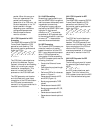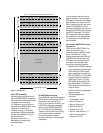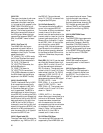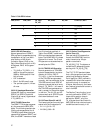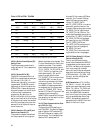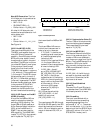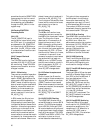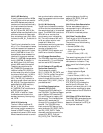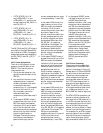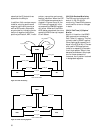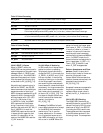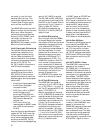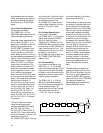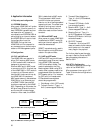31
3.9.4.2.9 APS Monitoring
If the K1 byte and the four MSBs
of the K2 byte, which are used to
send APS requests and channel
numbers, are received identically
for three consecutive frames,
their values are written to
RX_K1[7:0] and RX_K2[7:4]. Ac-
cepted values are compared to the
previous contents of these regis-
ters, and when a new 12-bit value
is stored, the RX_K1_D delta bit is
set.
The K1 byte is checked for insta-
bility. If, for 12 successive frames,
no three consecutive frames are
received with identical K1 bytes,
the K1_UNSTAB bit is set. It is
cleared when three consecutive
identical K1 bytes are received.
When K1_UNSTAB changes state,
the K1_UNSTAB_D delta bit is
set. Bits 3 down to 0 of K2 may
contain APS mode information.
These bits are monitored for
K2_CONSEC[3:0] consecutive
identical values. RX_K2[3:0] is
written when this occurs, unless
the value of bits 2 and 1 of K2 is
11 (indicating Line/MS AIS or
RDI). The RX_K2_D delta bit is
set when a new value is written to
RX_K2[3:0]. The three delta bits
associated with APS monitors,
RX_K1_D, RX_K2_D and
K1_UNSTAB_D all contribute to
an APS interrupt signal,
APS_INTB. In addition, these
three deltas contribute to the
standard summary interrupt sig-
nal, INTB.
3.9.4.2.10 S1 Monitoring
The four LSBs of received S1
bytes are monitored for consis-
tent values in eight consecutive
frames in SONET mode or three
consecutive frames in SDH mode.
When these bits contain a consis-
tent synchronization status mes-
sage, the accepted value is written
to RX_S1[3:0].
3.9.4.2.11 M1 Monitoring
The M1 byte indicates the number
of B2 errors that were detected by
the remote terminal in its received
signal. The HDMP-3001 contains a
20-bit M1 error counter that
counts every error indicated by
M1. The valid values of M1 are 0
to 24; any other value is inter-
preted as 0. When the
performance monitoring counters
are latched, the value of this
counter is latched to the
M1_ERRCNT [23:0] register, and
the M1 error counter is cleared.
3.9.4.3 Transport Overhead Drop
The TOH/SOH drop block outputs
the received E1, F1, and E2 bytes
and two serial DCC channels.
3.9.4.3.1 Orderwire (E1 and E2) and
Section User Channel (F1)
The three serial outputs,
RX_E1_DATA, RX_E2_DATA, and
RX_F1_DATA, contain the values
of the received E1, E2, and F1
bytes. A single 64 kHz clock refer-
ence output (RX_E1E2F1_CLK) is
provided as well.
3.9.4.3.2 Data Communications
Channels, DCC, (D1-D12)
There are two DCCs defined in
the TOH/SOH. The Section/Regen-
erator Section DCC uses the D1,
D2, and D3 bytes to create a 192
kb/s channel. The Line/Multiplex
Section DCC uses bytes D4
through D12 to create a 576 kb/s
channel. The TOH/SOH drop
block outputs DCC data on two
serial channels, RX_SDCC_DATA
and RX_LDCC_DATA. These
channels are synchronous to the
outputs RX_SDCC_CLK and
RX_LDCC_CLK. The DCC data
outputs change on the falling
edges of RX_SDCC_CLK and
RX_LDCC_CLK.
3.9.4.4 Pointer State Determination
Pointer state determination in-
volves examining H1-H2 bytes to
establish the state of the
STS-3c/AU-4 received pointer.
3.9.4.5 State Transition Rules
The first pair of H1-H2 bytes con-
tain the STS-3c/AU-4 pointer.
They are in one of the following
three states:
• Normal (NORM = 00)
• Alarm Indication Signal
(AIS = 01)
• Loss of Pointer (LOP = 10)
The remaining two pairs of H1-H2
bytes are monitored for correct
concatenation indication. They
are in one of the following three
states:
• Concatenated (CONC = 11)
• Alarm Indication Signal
(AISC = 01)
• Loss of Pointer (LOPC = 10)
The individual states are stored in
PTR_STATE[1:0], where
PTR_STATE[1:0] indicates the
state of the H1-H2 bytes. The
states of individual pairs of H1-H2
bytes are then combined to deter-
mine the state of the STS-3c/AU-4
pointer.
3.9.4.6 State of STS-3c/AU-4 Pointer
The HDMP-3001 generates the sta-
tus bits RX_PAIS and RX_LOP
based on the state of the STS_3c/
AU-4 pointer received.



